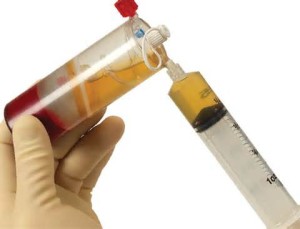
But what is in platelets that makes them so potentially useful? Platelet rich plasma is the processed clear plasma that is separated from the red blood cells from the patients’ own blood. But it is the platelets that have the active ingredients.There are many bioactive molecules that are in the granules inside the platelets. These include growth factors, adhesive proteins, clotting factors, fibrinolytic factors, proteases and membrane glycoproteins. But it is the growth factors in PRP that has received the greatest attention and with a name like ‘growth factor’ it is easy to understand why.
The growth factors that have been identified in the platelets in PRP is a lengthy list. These include PD-EGF (platelet-derived epidermal growth factor), PDGF-A and B (platelet-derived growth factor), TGF-B1(transforming growth factor), IGF I and II (insulin-like growth factor), VEGF (vascular endothelial growth factor), ECGF (endothelial cell growth factor), bFGF (basic fibroblast growth factor) and CTGF. (connective tissue growth factor) These growth factors work by sending signals to numerous cell types, such as stem cells in the target tissues, allowing them to induce repair and the stimulus to produce new cells.
The aesthetic use of PRP has largely focused on skin rejuvenation and, lately, that of hair restoration. It is often combined with other known aesthetic agents to create a synergistic effect. While some mix it with injectable fillers and fat, the most common usage today is with skin microneedling and laser resurfacing. Microchannels are made in the skin using microneedles on a roller or the fractional laser. PRP is applied and is then absorbed into the skin through these channels to provide a stimulatory effect on the underlying tissues and cells right under the skin. Adjuvant treatment with platelet-rich plasma is yet another advancement in the quest for an improved facial skin appearance.
Another method to deliver PRP directly is with blunt microcannulas or needles placed right into and under the skin. This is how treatments are largely done for hair restoration. This can be done as a treatment of hair loss in both men and women. It can also be done either before or after hair transplantation or both. It is somewhat like adding fertilizer to the lawn or garden both before and after planting.
Dr. Barry Eppley
Indianapolis, Indiana


